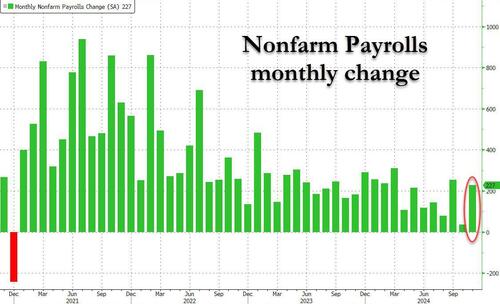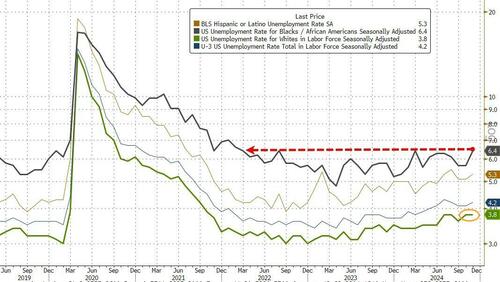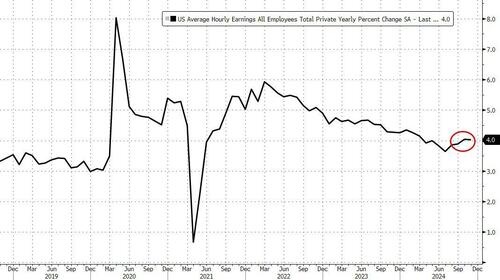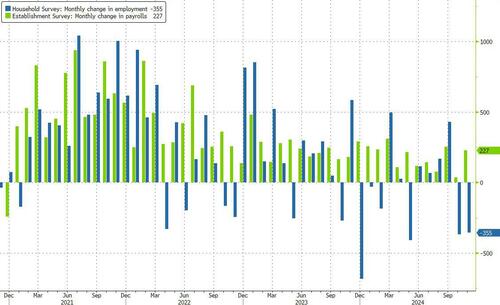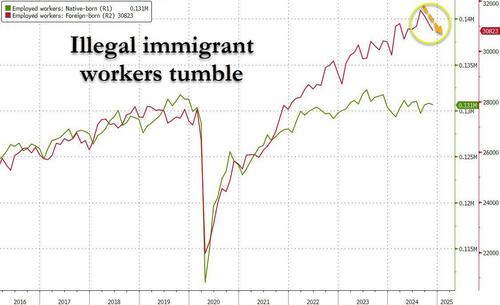November Jobs Surge Above Estimates As Wage Growth Comes In Hot, Unemployment Rises
After the October hurricane-driven debacle which sent last month's payrolls print to the lowest in years, at just 12K, traders were expecting a solid bounce today, with many whispering a print that would come above the consensus estimate of 220K... and they were right: moments ago the BLS reported that in November, payrolls growth surged to 227K, the second highest print since March (after the upward September revision).
Unlike previous month, most of which had all seen downward revision, the previous two months were revised higher, September was revised up by 32,000, from +223,000 to +255,000, and the change for October was revised up by 24,000, from +12,000 to +36,000. With these revisions, employment in September and October combined is 56,000 higher than previously reported.
The rebound reflects swings related to the end of the Boeing strike and the hurricanes that skewed the October data; hiring was led by health care and social assistance, as well as leisure and hospitality and government (see below)
Those looking for a clear indication whether the Fed will keep cutting or halt its easing cycle in two weeks, will have to wait because the rest of the jobs report was mixed: on one hand, unemployment rose from 4.1% to 4.2%, and above the 4.1% estimate (with Black unemployment at 6.4% rising in November, while the jobless rates for adult men (3.9 percent), adult women (3.9 percent), teenagers (13.2 percent), Whites (3.8 percent), Asians (3.8 percent), and Hispanics (5.3 percent) showed little or no change over the month)...
...but hourly earnings also rose, rising 0.4% MoM in November, above the 0.3% estimate, with annual wage growth flat at 4.0%, also above the 3.9% estimate, both indicating that wage growth pressures remain.
We should note that while the Establishment report gain of 227K payrolls was solid, the Household survey indicated a much bigger weakness, with the number of people employed tumbling by 355K to 161.141 million.
Tied to that, both the full-time and part-time series showed a notable drop (since these track the Household Survey), with full-time jobs dropping by 111K and part-time jobs down by 268K.
Taking a closer look at the report we find the following:
- The number of long-term unemployed (those jobless for 27 weeks or more) was little changed at 1.7 million in November. This measure is up from 1.2 million a year earlier. In November, the long-term unemployed accounted for 23.2 percent of all unemployed people.
- The labor force participation rate, at 62.5 percent, changed little in November and has remained in a narrow range of 62.5 percent to 62.7 percent since December 2023. The employment-population ratio, at 59.8 percent, also changed little over the month but is down by 0.6 percentage point over the year.
- The number of people employed part time for economic reasons changed little at 4.5 million in November. This measure is up from 4.0 million a year earlier.
- The number of people not in the labor force who currently want a job, at 5.5 million, changed little in November. These individuals were not counted as unemployed because they were not actively looking for work during the 4 weeks preceding the survey or were unavailable to take a job.
- Among those not in the labor force who wanted a job, the number of people marginally attached to the labor force, at 1.6 million, was unchanged in November. These individuals wanted and were available for work and had looked for a job sometime in the prior 12 months but had not looked for work in the 4 weeks preceding the survey.
- The number of discouraged workers, a subset of the marginally attached who believed that no jobs were available for them, changed little at 396,000 in November.
Taking a look at jobs by sector, we find that employment trended up in health care, leisure and hospitality, government, and social assistance. Employment increased in transportation equipment manufacturing, reflecting the return of workers who were on strike. Despite the onset of the Holiday season, retail trade cut 28,000 jobs the most jobs in a year, while durable goods manufacturing jobs jumped by 26,000 upon the conclusion of the Boeing strike. Yet while overall manufacturing employment rose due to an extra 32,000 transportation equipment roles, the sector was otherwise mixed; the semiconductor and electronic component sector lost 3,500 jobs. Here are some more details:
- Health care added 54,000 jobs in November, in line with the average monthly gain of 59,000 over the prior 12 months. In November, ambulatory health care services added 22,000 jobs, led by a gain of 16,000 in home health care services. Employment also increased in hospitals (+19,000) and nursing and residential care facilities (+12,000).
- Employment in leisure and hospitality trended up in November (+53,000), following little change in the prior month (+2,000). Over the month, employment trended up in food services and drinking places (+29,000). Leisure and hospitality had added an average of 21,000 jobs per month over the prior 12 months.
- In November, government employment continued to trend up (+33,000), in line with the average monthly gain over the prior 12 months (+41,000). Over the month, employment continued to trend up in state government (+20,000). However, it is notable that there was a 2,000 drop in Federal employees in the month, the biggest drop in two years.
- Employment increased by 32,000 in transportation equipment manufacturing in November, reflecting the return of workers who were on strike.
- Employment in social assistance edged up by 19,000 in November, similar to the average monthly gain of 18,000 over the prior 12 months. Over the month, individual and family services added 17,000 jobs.
- Retail trade lost 28,000 jobs in November, after showing little net employment change over the prior 12 months. In November, employment declined in general merchandise retailers (-15,000), while electronics and appliance retailers added jobs (+4,000).
And visually:
Finally, for those trying to figure out what all this means, here is perhaps the most important chart: after hitting a record high in August, the number of illegal alien workers has tumbled (even as native-born workers remain flat). This suggests that wage growth is about to surge as employers will now be "forced" to hire domestic employees, who unlike their Guatemalan peers, have the ability to negotiate higher wages.


